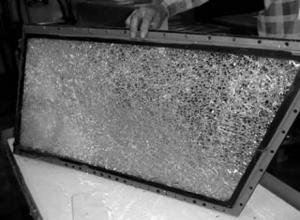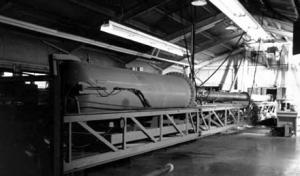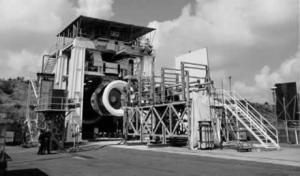- Introduction
- Certification standards
- Design and material changes to airframe and engine components
- Bird-impact testing
- Conclusion
Introduction
All forward-facing aircraft parts—especially engines—are vulnerable to damage when aircraft and wildlife collide, as discussed in Chapter 7. Existing airframe- and enginecertification standards for aircraft presently in operation were described in Chapter 5. This chapter discusses advances by manufacturers and regulators in ensuring the bird worthiness of airframes and engines—improving the ability of aircraft to withstand bird and mammal strikes.
Current research and development focuses on three areas:
- certification standards,
- design and material changes to components, and
- impact testing.
Certification standards
Airframe and engine airworthiness standards are subject to periodic review. Occasionally, new data from accident reports and safety reporting systems indicates that current standards require enhancement to more closely reflect operating environments. At such times, regulatory bodies endeavour to revise the standards.
New certification standards strive to enhance safety without invoking undue economic penalties that might result from new-regulation implementation. This is one of the reasons that new standards are not applied to airframes and engines certified under old rules.
Additionally, the regulatory process is time consuming, involving exhaustive research and collaboration. Proposed rule changes are submitted to the industry for comments that are evaluated and integrated into the new or revised standards. It is not unusual for this process to take several years.
International harmonization of airworthiness requirements
As discussed in Chapter 5, there are two bodies that certify airframes and engines:
- the Federal Aviation Administration (FAA), and
- the European Joint Aviation Authority (JAA).
Generally, aircraft are certified to both FAA and JAA standards, although meeting the differences in these standards can increase both the costs to manufacturers and the length of the certification process.
In the last few years the FAA and JAA have made a concerted effort to ensure worldwide airworthiness regulations are consistent in form and substance, thereby lowering certification costs and enhancing global aviation safety.
An example of this harmonization can be found in the August 8, 1996 FAA amendments to airworthiness standards for Normal (FAR 27) and Transport Category (FAR 29) rotorcraft—amendments that improved standards for helicopter performance, systems, propulsion and airframes. These changes were also the first to incorporate bird-strike protection requirements. The proposed amendments were reviewed by a number of groups including:
- major rotorcraft manufacturers,
- Aerospace Industries Association of America, Inc.,
- Association Européene des Constructeurs de Matérial Aerospatiale,
- Helicopter Association International,
- European Joint Aviation Authorities (JAA),
- Transport Canada, and
- the United Kingdom Civil Aviation Authority.
The JAA agreed not only with the proposed FAA rule, but also the effort to harmonize certification standards and regulations in the United States and the European communities. To realize full harmonization objectives, the JAA prepared and published its own identical regulation to coincide with the final rule for Parts 27 and 29 of the FARs. The goal is to continue the harmonization process through the remainder of the regulations over the next few years.
More stringent bird-impact airworthiness requirements
One effective way to reduce the severity of wildlife strikes is to enact more stringent impact-strength requirements for airframes and engines.
Airframe airworthiness requirements modifications
Presently, there are no published proposals to enhance airframe bird-impact requirements. Yet recent analysis of bird-population and strike-incident data indicates marked increases in the number of bird strikes involving large-bird species—species that, in weight and size, exceed the current certification requirements for windshields and airframes. In many cases, strikes involving such birds have led to windshield penetrations, serious pilot injuries and significant and costly airframe damage.
|
Aircraft Speed (Knots) |
|||||||||
| Bird Species & Weight (lbs.) | 100 | 150 | 200 | 250 | 280 | 300 | 350 | 400 | 450 |
| Starling 0.187 (3 ozs.) | 995 | 2,238 | 3,978 | 6,216 | 7,798 | 8,951 | 12,184 | 15,913 | 20,140 |
| Ring-billed Gull 1.5 | 2,775 | 6,244 | 11,100 | 17,343 | 21,756 | 24,974 | 33,993 | 44,399 | 56,193 |
| Duck 4.0 | 6,078 | 13,676 | 24,314 | 37,990 | 47,655 | 54,706 | 74,461 | 97,255 | 123,088 |
| Canada Goose 15.0 | 9,118 | 20,515 | 36,471 | 56,985 | 71,482 | 82,059 | 111,691 | 145,883 | 184,633 |
Table 12.1 Approximate Bird-impact Forces (lbs.)
Bird-population data show that the Canada Goose population in North America has increased from two million in 1990 to more than six million at the end of 1999; approximately 40 percent of the North American Canada Goose population remains in urban areas year round. Many geese weigh well over 15 lbs, and it is not unusual for individual specimens to exceed 18 lbs—sobering figures when considering that current standards for windshield impact strength are based on a four-lb bird hitting an aircraft at design cruise speed (Vc).
Table 12.1 shows approximate impact forces by bird weight and impact speed. Accordingly, we see that a four-lb bird striking a windshield at 300 kts generates an impact force of up to 55,000 lbs. Meanwhile, a 15-lb goose hitting a windshield at 300 kts generates an impact force of up to 82,000 lbs—a force that exceeds windshield certification standards by 200 to 300 percent (See Appendix 12.1 and 5.1).
While the data provide compelling evidence, suggesting more stringent airframe birdimpact certification standards may be required, the potential costs involved in upgrading the bird-worthiness of the current fleet of legacy aircraft would be enormous.
Modifications to airworthiness requirements
On September 14, 2000, the FAA issued revised bird-ingestion standards for jet engines (FAR 33), responding to data that define the actual bird threat encountered by jet engines in service. These standards also reflect a desire to harmonize the FAA bird-ingestion criteria with those being drafted by the JAA—standards that recognize both the capacity of new large-inlet turbine engines to ingest an increased number of birds, and the actual weights of birds being ingested.
This B737 windshield was damaged as a result of a bird strike at 10,000 ft ASL.
large birds weighing 4 lbs, and medium flocking birds weighing 1.5 lbs. During the regulatory development process, the industry agreed that multiple strikes involving these birds must also be considered as part of the new-engine certification process. As a result, the large-bird requirement was updated to range from 4 to 8 lbs, based on information obtained from bird-weight averages recorded during the 1990 FAA Large, High Bypass Ratio Engine Study.
The FAA study also reviewed bird population data, and identified the 2.5-lb Herring Gull as a potential flocking-bird hazard at most coastal airports in the Northern Hemisphere. To confirm this suspicion, an evaluation of the observed weights of birds ingested into jet engines was carried out.
Following the review, a new certification standard was established, updating design and testing requirements for all jet-engine sizes, and enhancing bird-ingestion test requirements for large, high bypass-ratio turbofan engines. The revised standard addresses strikes by single large birds as well as those by flocks of birds, and sets out a number of parameters for assessments of engine airworthiness. The September 14, 2000, FAR 33 revised bird-ingestion engine certification standards are contained in Table 12.2.
| Original Certification Standard | Revised Certification Standard (Sep. 2000) | ||||
| Engine | Inlet Area Sq. in. | Large-bird Quantity & Weight | Medium-bird Quantity & Weight | Large-bird Quantity & Weight | Medium-bird Quantity & Weight |
| JT8D | 2290 | 1 @ 4.0 lbs. | 4 @ 1.5 lbs. | 1 @ 6.05 lbs. | 1 @ 2.53 lbs. plus 3 @ 1.54 lbs. |
| RB211 | 4300 - 5808 | 1 @ 4.0 lbs. | 4 @ 1.5 lbs. | 1 @ 6.05 lbs. | 1 @ 2.53 lbs. plus 6 @ 1.54 lbs. |
| JT9D | 6940 | 1 @ 4.0 lbs. | 4 @ 1.5 lbs. | 1 @ 8.03 lbs. | 3 @ 2.53 lbs. |
| PW2037/2043 | 4902 | 1 @ 4.0 lbs. | 4 @ 1.5 lbs. | 1 @ 6.05 lbs. | 1 @ 2.53 lbs. plus 6 @ 1.54 lbs. |
| CF6 | 6973 | 1 @ 4.0 lbs. | 4 @ 1.5 lbs. | 1 @ 8.03 lbs. | 3 @ 2.53 lbs. |
| CFM56 | 2922 - 4072 | 1 @ 4.0 lbs. | 4 @ 1.5 lbs. | 1 @ 6.05 lbs. | 1 @ 2.53 lbs. plus 6 @ 1.54 lbs. |
| V2500 | 3217 | 1 @ 4.0 lbs. | 4 @ 1.5 lbs. | 1 @ 6.05 lbs. | 1 @ 2.53 lbs. plus 4 @ 1.54 lbs. |
| PW4000 | 6940 - 7854 | 1 @ 4.0 lbs. | 4 @ 1.5 lbs. | 1 @ 8.03 lbs. | 4 @ 2.53 lbs. |
Table 12.2 Original & Revised FAR 33 Engine Certification Bird Weight & Quantity Requirements for Engines Shown in Chapter 5, Table 5.1 (1)(2)(3)
(1) RR Trent 553/768/875/8104, PW4084/4098 and GE90 were voluntarily certified to revised standard and are not shown.
(2) Original small-bird ingestion certification requirements for all listed engines is 16 birds @ 0.187 lbs.
(3) Revised small-bird ingestion certification requirements for all listed engines is 16 birds @ 0.187 lbs.
Table 12.2 compares the old and new engine certification standards with respect to bird-weight requirements for engines listed in Chapter 5, Table 5.1. The large turbofan engines (RR Trent Series, P&W 4084/4098 and the GE90) are not included in this table; these engines were voluntarily tested by manufacturers to meet the new certification standards.
More recent industry data raises questions about assumptions that informed the new certification standards. The two major concerns are:
- the assumption that large-bird ingestions will only affect one engine. Strike data hasshown an unusual increase in the number of strikes involving large birds to morethan one engine.
- the assumption of a maximum large-bird impact speed of 200 kts. This assumptionis based on speeds during approach and departure, and that aircraft are more likelyto encounter large birds at the altitudes (below 500 ft) in which these phases offlight occur. In fact, many current regulations permit aircraft to undertakeapproaches and departures at speeds of 250 kts and greater, and these higher impactspeeds could result in considerably more serious damage.
Design and material changes to airframe and engine components
Advancements in computer-assisted design and manufacturing (CAD/CAM) have led to a number of improvements in airframe and engine design. New materials— such as carbon-fiber composites—offer superior strength and reduced weight.
Developments in airframe design and materials
Efficiency motivates new airframe design work, using lighter, stronger materials to improve specific fuel consumption and aircraft range—rather than improve birdimpact strength.
Significant improvements have been made in protecting critical components such as fuel lines, flight-control cables, hydraulic lines and electrical wiring—ensuring their operation is not impaired by wildlife strikes. Relocating these components within wings and fuselages reduces the likelihood of significant damage leading to multiple system failures, and improves overall survivability of aircraft.
The development of fly-by-wire control systems was a positive step toward reducing bird-strike damage to aircraft. This approach to flight-control system design— motivated by considerable aircraft weight savings—conveys flight-deck control information through computers. The computers process a range of control parameters and distribute signals to appropriate flight-control actuators. Prior to flyby- wire systems, control rods and cables directly connected flight decks to specific control surfaces (with or without some type of power boost).
New fly-by-wire systems reduce vulnerability of flight controls by eliminating complicated control components that run through wings, fuselage and tail surfaces. Fly-by-wire systems are also designed to incorporate multiple layers of redundancy, constructed to allow for the independent movement of individual control surfaces through back-up computer and hydraulic systems. Compensation for control-system damage is achieved by increasing control movements on surfaces unaffected by an impairment.
One disadvantage of fly-by-wire systems is that they provide no direct physical feedback from control surfaces—pilots are unable to feel any control flutter as a result of damage. Fly-by-wire flight-control systems do have electronic control-position indicators, but these instruments lack sufficient fidelity to detect aerodynamic flutter—an important indicator of the level of damage to control surfaces. If it reaches sufficient magnitude or frequency, aerodynamic flutter can ultimately lead to structural failure and loss of control.
Aircraft-transparency strength has benefited from research and development in both new materials and heating systems that help maintain the flexibility of windshields. Further research is being conducted on military aircraft, using composite materials to strengthen windshield frames. In addition, the USAF Next Generation Transparency Program is developing injection-molded frameless transparencies for fighter aircraft. Lighter than existing models, these transparencies have fewer parts, reduce changeout
Injection-molded frameless canopies which are very resistant to bird strike damage are being developed by the USAF.
time and are much more resistant to bird strikes. Positive developments from this military research will eventually be transferred into improvements in civilian-aircraft windshield construction.
Developments in engine design and materials
Developments in engine technology have been dramatic, with the high bypass-ratio turbofan becoming the engine of choice on virtually all new large commercial aircraft. The high-thrust output of these engines makes it possible to power large aircraft such as the Boeing B777 and the Airbus A330 with only two engines. The benefits include increased fuel efficiency and reduced maintenance costs compared to the three or four engines typically used in earlier generation aircraft such as the DC8, B707, L1011 and DC10.
New generation aircraft engines have been designed to meet the latest engine airworthiness certification standards. Computer design technology and advanced materials lead to fan, compressor and turbine blades that are wider and longer and improve thermodynamic efficiency. The improved structural integrity of these components has also improved their resistance to damage from bird impacts.
New aircraft engines also use advanced full-authority digital engine controls (FADEC) to optimize engine performance. FADEC provides enhanced enginemonitoring and warning systems that adjust engine parameters to maintain required thrust even when the engine has sustained damage. FADEC systems automatically select engine ignition on when engine flameout is sensed.
Photo courtesy of Tony Bosik
Figure 12.1 Apparatus for testing windshields and airframe components.
Bird-impact testing
Through bird-impact testing, new engines and airframes are subjected to simulated and actual bird strikes.
Aircraft windshields and airframes are tested using compressed air cannons, which direct euthanized birds against airframe components at designated speeds. The components are wired to instruments that measure impact forces and component distortion. High-speed films provide slow-motion playback, illustrating damage progression and bird trajectory after impact. Figure 12.1 shows a typical bird-impact test installation for windshields.
Engine testing begins on individual fan blades that are subjected to impact-loading tests to verify structural integrity. Euthanized birds are then fired into running engines from multi-barrel air guns. The engines are carefully monitored during both impact and a fixed-time run-on period following impact, recording engine parameters such as pressures, temperatures, accelerometer forces and strain-gauge values. Impact tests are also filmed at high speed to observe bird trajectories and engine-blade deformation. Figure 12.2 shows an example of aircraft engine bird-impact testing equipment.
Recently, airframe and engine manufacturers have investigated the use of computer simulation in modelling bird strikes. This technique will prove extremely useful during research and development, eliminating costly live testing that sometimes results in the destruction of prototype engines and windshields. Manufacturers are also examining the use of model birds for impact testing—tools that not only offer consistent density and shape and more accurate test results, but also address concerns raised by animal- welfare groups.
Photo courtesy of Rolls-Royce plc
Figure 12.2 Bird impact test facility for jet engines.
Conclusion
The aviation manufacturing industry strives to continuously improve product quality. In order to reduce the potential for damage from a wildlife strike, the following principles should be addressed:
- Airframe and engine manufacturers must continue to evaluate data to ensure thatcertification standards reflect real-life bird-strike risks.
- Manufacturers must apply design-technology and material advances to engines andairframes to improve bird-impact resistance. However, when new materials are usedto achieve benefits such as weight reduction—as in composite propellers onmodern turboprop transport aircraft—the industry must ensure that failureproperties are properly tested.
- Manufacturers must continually evaluate and modifytesting methods to ensure that they reflect actual scenarios.
- The industry should remember that although new certification standards haverecently been implemented—and that newer standards are being developed—engines certified to the old rules remain the most common throughout the jet transport fleet, and will continue to be for another generation. The increased birdstrike threat has led to improved standards only for the design and construction offuture engines. This weak link in the safety chain reinforces the importance of airport bird-management efforts.



